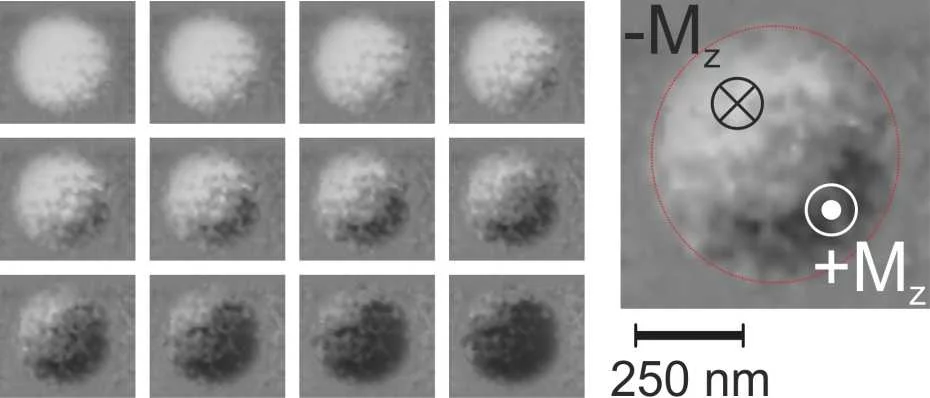There is a strong correlation between the rise of a civilization and writing. The so-called Information Age developed in parallel with the ability to write, store, and process large amounts of digital data. To keep pace with the increasing demand for data of our days, not only the size but also the speed of digital memories must increase dramatically, while keeping the energy consumption at reasonable levels. In order to achieve that, we must learn to write anew.
As in our everyday experience, writing requires a support, such as paper, and a pen. In the digital world, the support is either a semiconductor or a magnetic thin film, whereas the “pen” is either an electrical signal or a magnetic field. Magnetic supports are preferred when data have to be stored for long periods and written over multiple times. The problem, however, is the “pen”. Magnetic fields are typically produced by sending a strong electrical current through a coil, which, even when miniaturized, takes up a lot of space and disperses most of its energy in empty space. Fortunately, there are novel and better ways to write magnetic data.
In 2011, the team of Prof. Pietro Gambardella (ETH, Department of Materials) has pioneered a new method to switch the magnetization of thin films and nanostructured magnetic elements by fabricating bilayer bits including a magnetic layer for storage and a heavy metal layer for charge-spin conversion. The method works by sending an electric current inside the bit, parallel to the magnetic film’s surface. Thanks to the rather exotic but powerful spin Hall and interfacial spin polarization effects, the heavy metal layer converts the charge current into a spin current, which is then absorbed by the magnetic layer inducing the reversal of the magnetization. Such a local reversal mechanism minimizes energy dispersion and allows for scaling of the electrically-controlled magnetic bits to below a few tens of nanometers. Now it was shown that the current-induced switching occurs on an extremely fast timescale, less than 1 nanosecond, and that the magnetic bits endure a trillion writing and erasing cycles, which is more than enough to guarantee the safe functioning of a memory, even for the most solicited ones such as CPU caches and RAMs. Further, the microscopic mechanisms and interactions that attend the current-induced magnetization reversal were elucidated. The results of this work were published in Nature Nanotechnology.
This work is a collaboration between two ETH groups (Prof. Pietro Gambardella at the Department of Materials and Dr. Yves Acremann at the Department of Physics) and the PolLux staff of the Swiss Light Source, where time-resolved microscopy experiments were performed. By taking advantage of a unique experimental setup that includes a scanning x-ray transmission microscope, our teams achieved a spatial resolution of 25 nm and a temporal resolution of a 100 picoseconds, which allowed for the imaging of the initial and intermediate steps of the magnetization reversal process of cobalt/platinum dots as a function of time during current injection. Besides proving that the switching is extremely fast, it was shown that the reversal process is deterministic due to the asymmetric nucleation of magnetic domains at precise edge locations of the magnetic dots, which are favored by the current-induced torques and interfacial effects (the Dzyaloshinskii-Moriya interaction). As the switching unfolds along a reproducible and deterministic path, the timing and the extent of magnetization reversal can be reliably controlled by the amplitude and duration of the current pulses as well as by the sample dimensions and by independent engineering of the material properties that affect the charge-spin conversion process. Overall, the data demonstrate the speed and reliability of a new type of magnetic writing, which can be used to control the magnetization of a broad variety of magnetic systems in two and three-terminal electrical devices with minimal energy consumption.
Additional information
ETHZ media releaseContact
Prof. Pietro GambardellaMagnetism and Interface Physics
HPP N 14.1
Hönggerbergring 64
8093 Zürich, Switzerland
E-Mail: pietro.gambardella@mat.ethz.ch
Phone: +41 44 633 07 56
Original Publication
Time- and spatially-resolved magnetization dynamics driven by spin-orbit torquesM. Baumgartner, K. Garello, J. Mendil, C. O. Avci, E. Grimaldi, C. Murer, J. Feng, M. Gabureac, C. Stamm, Y. Acremann, S. Finizio, S. Wintz, J. Raabe and P. Gambardella
Nat. Nano. 12, 980 (2017)
DOI: 10.1038/nnano.2017.151
